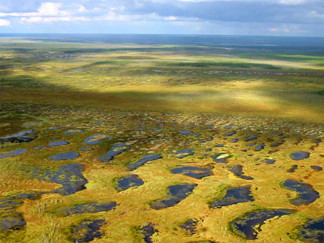 A study of 96
watersheds in western Siberia is showing an alarming trend: If temperatures
in the region and throughout the Arctic continue to rise, by the end of this
century, land surface that is covered by permafrost will be halved — leaching
carbon into the area’s water system. Considering that vegetation throughout
West Siberia contains one-third of the carbon buried in the world’s soils,
such a permafrost loss could dramatically affect the global climate cycle.
A study of 96
watersheds in western Siberia is showing an alarming trend: If temperatures
in the region and throughout the Arctic continue to rise, by the end of this
century, land surface that is covered by permafrost will be halved — leaching
carbon into the area’s water system. Considering that vegetation throughout
West Siberia contains one-third of the carbon buried in the world’s soils,
such a permafrost loss could dramatically affect the global climate cycle.Dissolved organic carbon produces an orange color in water in West Siberia. New research is showing that as temperatures rise across the Arctic, carbon once locked up in permafrost soils may begin escaping into the area’s waterways. Courtesy of Karen Frey.
Most studies of the effects of melting Arctic permafrost tend to focus on direct emissions to the atmosphere of carbon dioxide and methane from the peat — compacted undecomposed plant matter — newly exposed beneath the melting permafrost. But, says Karen Frey, a hydrologist at the University of California, Los Angeles (UCLA), streams and rivers could also lead to atmospheric carbon dioxide emissions by carrying once-buried carbon out of the peat and into the ocean.
Peat up to 11 meters thick covers about 600,000 square kilometers of West Siberia — an area encompassing 2.6 million square kilometers — some exposed on the surface, some buried below the permafrost. Two of the world’s largest rivers drain this region, flowing into the Arctic Ocean, which exhibits the world’s highest flux of dissolved organic matter. Frey and her colleague Laurence Smith, also at UCLA, measured the dissolved organic carbon fluxes throughout streams and rivers in about 1 million square kilometers of land.
As reported in the May 5 Geophysical Research Journal, 43 of the streams the researchers measured were in permafrost areas, while the remaining areas were not. In permafrost-free areas, dissolved organic carbon concentrations in the water were higher where there was more peat. Where the permafrost was intact, however, the researchers measured very little dissolved organic carbon whether or not there was a lot of peat. Furthermore, Frey says, they found that on average, concentrations of carbon material in the permafrost-free areas were more than triple that in colder areas — indicating that increasing the amount of peat exposed in an area increases the amount of carbon released into the region’s waterways.
“Warmer temperatures are going to happen; there’s little question of that,” Frey says, and the warming is much more amplified in the Arctic than elsewhere — as a whole, studies suggest that the Arctic will rise 4 to 7 degrees Celsius over the next 100 years. Currently, 55 percent of West Siberia is perpetually frozen. “Our numbers show that, under the least conservative scenario, 98 to 99 percent of that area will warm above the temperature threshold” that keeps permafrost frozen, she says. Even if the warming were less, Frey says, “that’s pretty significant.”
Dissolved organic carbon leaches out of peat and is dumped into the Arctic Ocean, where bacteria decompose the carbon material over a decade. The carbon is then released as carbon dioxide into the atmosphere, thus providing yet another positive feedback system: As Earth warms, dissolving and decomposing peat releases more carbon into the atmosphere, thus warming Earth more, says Robert Holmes of the Woods Hole Research Center in Massachusetts. Just how much carbon dioxide could be released into the atmosphere from the decomposition of dissolved organic carbon from peat is a significant question, he says.
Although Frey says that direct carbon dioxide and methane emissions from the melting permafrost will be more significant, the amount of carbon released into the water from peat decomposition is still something that needs to be considered in climate models and carbon cycles.
Frey and Smith’s projections of dissolved organic carbon flux based on temperature increases are “significant and reasonable,” Holmes says. Researchers now need to figure out if the entire Arctic will behave this way, he says, and by how much the temperature will actually change over the next century.
Megan Sever

